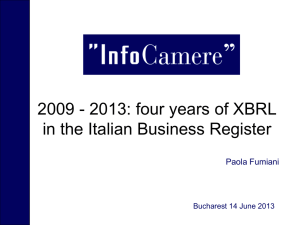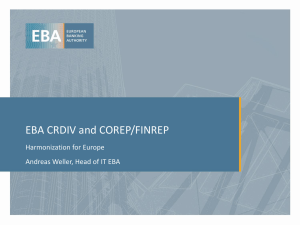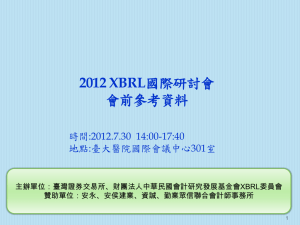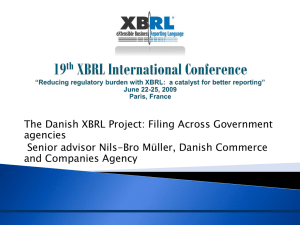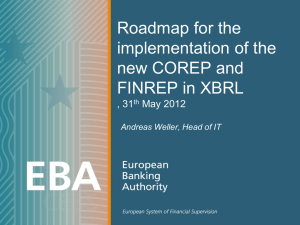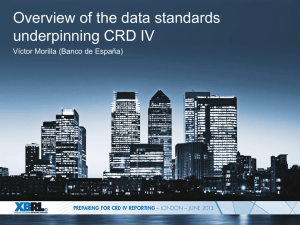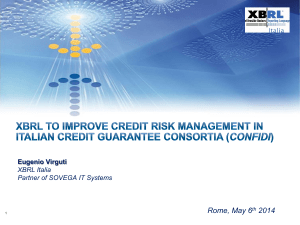Driving ROI through financial reporting
advertisement
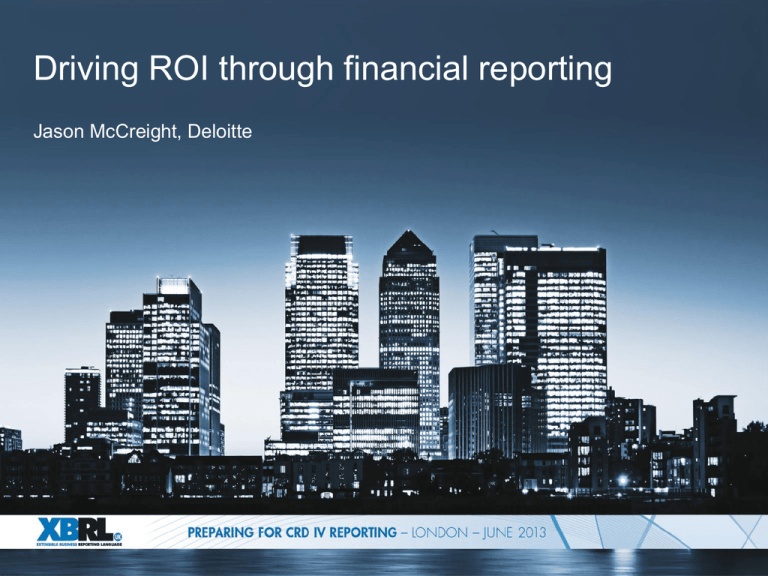
Driving ROI through financial reporting Jason McCreight, Deloitte Outline 1. 2. 3. 4. 5. 6. 7. 8. 9. 10. Introduction Regulatory landscape for banks XBRL XBRL and Multidimensionality Data Point Models and Dimensions Standardised Reporting Multidimensionality in Regulatory Reporting Implications For Banks Benefits Beyond Compliance Summary 1. Introduction A coming of age for regulatory reporting CRDIV proposes a number of measures to raise the quality, consistency and transparency of banks’ capital. XBRL submission of COREP and FINREP data will be mandatory: Q1 2014 XBRL is rapidly gaining acceptance as a standard global framework to support the more effective production, consumption and exchange of financial information. 2. Regulatory landscape for banks A recap of the past five years 2007 … 2011 2012 Basel I & II (CRD, II, III) 2013 2014 Basel III (CRDIV) European Directives 2015 … 2020 Basel III (CRDIV) CRD IV (European BASEL III adaptation) EBA Financial Supervision Manual EUC & paper reporting (European Supervisory Authority) Banking (National Supervisory Authority) Reporting Obligations COREP FINREP Automated “eRegulation” & XBRL 2. Regulatory landscape for banks “Navigating the Compliance Labyrinth”: A Deloitte Publication of respondents agreed strongly that compliance with regulatory requirements will become more challenging in the next 3-5 years 90% of respondents agreed strongly that compliance with regulatory requirements had become more challenging over the last five years 95% 159% Deloitte Centre for Banking Institutions: 20 of largest 50 US banks by assets http://www.finextra.com/finextradownloads/newsdocs/Deloittecompliance.pdf increase in expenditure on compliance 3. XBRL The basics What is XBRL? •A language for the electronic communication of business and financial data revolutionising business reporting •XBRL’s impact on financial reporting and data exchange has been compared to the impact of bar-coding on merchandising Why is it being adopted? •Mandated part of how financial organisations will have to submit automated prudential reports in the fourth iteration of the Capital Requirements directive (CRDIV) •Standards-based method allowing more efficient preparation, publishing, exchange, and analysis of regulatory financial data When will it become mandatory? •COREP and FINREP submissions must be made in XBRL •Banks should expect a global adoption of XBRL from Q1 2014 onwards Who benefits? •The cost savings stemming from greater efficiency and improved accuracy & reliability can be realised by all those involved in supplying or using financial data •The capabilities of the regulator to analyse and compare financial data will be dramatically enhanced. •Greater market efficiencies can be realised across global capital markets •Investors are allowed an “apples for apples” perspective when comparing financial information •Streamlining financial reporting processes can eliminate divergent systems within businesses, thus reducing costs 3. XBRL A global standard for business reporting “Tags” enable automated processing of business information by computer software, allowing the data to be treated “intelligently”. Shows how items are related to each other, thus representing how they are calculated. Powerful and flexible, specifically designed to meet the requirements of financial information. XBRL Local banks XBRL National Supervisory Authority Identifies whether data fall into particular groupings for organisational or presentational purposes. XBRL mandated by EBA European Banking Authority 4. XBRL and multidimensionality • A multidimensional database (MDB) is often called a “cube”. This is a dramatic simplification as they can often have many more than the 3 dimensions that this visually represents • It is a database optimised for analysis • These databases can rapidly process data so that answers can be found quickly • The data elements in the COREP reporting templates have been converted to a highly structured multi-dimensional data model • NSAs and banks can use the Data Point model to structure the design and processing of their internal reporting processes end systems. DPM Approach Traditional Approach DPM Bank NSA Requires manual interpretation and re-keying of data Bank NSA DPM approach allows both banks and NSAs to align their systems to the data definitions 5. Data Point Models and Dimensions Examples Data point model Dimension 6. Standardised Reporting Regulator Regulator XBRL Solution 1 Solution 2 Solution 3 Solution 1 Solution 2 Solution 3 Bank X Bank Y Bank Z Bank X Bank Y Bank Z • XBRL’s impact on financial reporting and data exchange has been compared to the impact of barcodes on merchandising • Like the barcode, XBRL is a system for coding and decoding information: i. Multiple forms of information consolidated into a single, standards-based format ii. A single piece of financial data is multidimensional 7. Multidimensionality in Regulatory Reporting CRDIV XBRL as a transition mechanism • Multidimensional data is very rich and powerful • In an ideal world a Regulator could provide an MDB & ask it to be populated. However numerous software companies provide solutions • It is this link that businesses can leverage to enhance other internal and external reporting and go “on the offensive”, whilst simultaneously adhering to regulatory standards Standardised Transmission of data between Banks & Regulators BANKS REGULATORY CUBE XBRL REGULATORY 8. Implications For Banks Regulators will have far more power and control over data in coming years, given the flexibility of the new XBRL reporting process. CRDIV will be an evolutionary process and will require time for the standards to stabilise and become clear. Domestic and foreign banking institutions should expect tougher oversight and enforcement of regulatory compliance, beyond COREP and FINREP. “Apples to Apples” Comparability Banks should expect to further investment requirements in 2014 and beyond. Regulator Power, Control & Insight Investor demands for high quality information Response to change 9. Benefits Beyond Compliance Value-add effort maximisation Standards-based Extensible Automated Reliable Transparent Convergent XBRL Consistent 10. Summary • • • • • • • XBRL is a data transmission mechanism. However it is different to many of its predecessors as it allows the richness of multidimensionality to be built in & retained This kind of technology is quite new – it has been around for 20 years It has been adopted & used consistently in Finance functions; handling results consolidation & publication, planning & analytics Today’s principle point was that it can also be used more in the Regulatory area. Wider use should help to produce and analyse accurate data more efficiently It can be used both by the banks & the regulators to drive greater compliance but should also produce benefits beyond this


